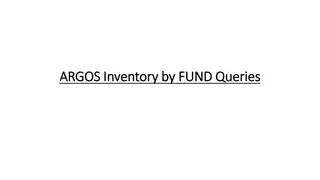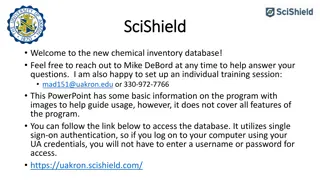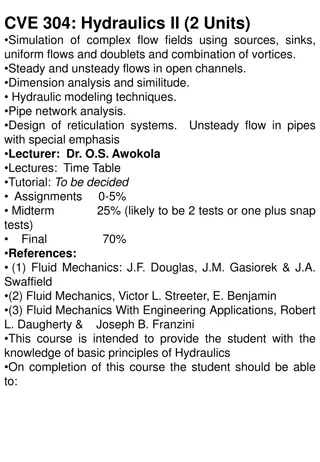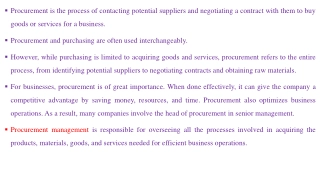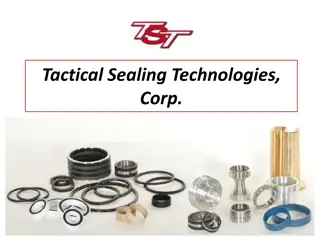Optimizing Process Flow and Inventory in LittleField Technologies Game
Understand concepts like Theoretical Flow Time, Pipeline Inventory, and Max-WIP to improve production efficiency and reduce bottlenecks in LittleField Technologies game simulations.
Download Presentation
Please find below an Image/Link to download the presentation.
The content on the website is provided AS IS for your information and personal use only. It may not be sold, licensed, or shared on other websites without obtaining consent from the author. Download presentation by click this link. If you encounter any issues during the download, it is possible that the publisher has removed the file from their server.
Presentation Transcript
Process Flow Analysis In the Context of LittleField Technologies Game Ardavan Asef-Vaziri
Pipeline Inventory & Max-WIP, LittleField Technologies. A. Asef-Vaziri. 2
One Machine Per Station; Theoretical Flow Time (ThT) I will review some of the Process Flow and Little s Law concepts in the context of Littlefield Technologies (LFT) game. Contract Flow unit. Machine Resource unit, Station Resource pool. Minimal flow time, or theoretical flow time (ThT): The minimal time required to produce a flow unit. Minimal inventory or pipeline inventory (Ip): The minimal inventory required to produce a flow unit. Min-WIP. The Maximal inventory or Maximal Work in Progress (Max-WIP) to regulate WIP to achieve the expected flow time (T). Ensure that I or WIP remains less than (but not much less than) Max-WIP. The time in the waiting lines (Ti) vs in processes (Tp). The number of flow units in the waiting lines (Ii) vs in processes (Ip). Pipeline Inventory & Max-WIP, LittleField Technologies. A. Asef-Vaziri. 3
The Situation-Not the Same Numbers as in Your Game Where is the bottleneck? The station with the highest utilization. Station 2. R=5.5 c=1 Rp1=8/day Tp=24/8=3 c=1 Rp1=6/day Tp=24/6=4 Compute Rp U=R/Rp Rp=R/U c=1 U= 0.6875 U= 0.6875 c=1 U= 0.916666 U= 0.916667 5.5 Sta-1 Sta-2 Sta-3 U 0.6875 0.916666 0.55 Rp/dy 8 6 10 Tp in dy Tp in hr 0.125 0.167 0.1 3 4 2.4 Compute unit load (Tp) at each station Rp = c/Tp Tp =c/Rp c=1 in all stations Tp=1/Rp day c=1 Rp1=10/day Tp=24/10=2.4 c=1 U= 0.55 U= 0.55 Pipeline Inventory & Max-WIP, LittleField Technologies. A. Asef-Vaziri. 4
Capacity & Theoretical Flow Time (ThT) Compute Capacity of this System (Rp). Capacity of the system = Min(8,6,10) = 6 per day. Compute Theoretical Flow Time (ThT) ThT is the minimal time that we need to produce a product. ThT = 3+4+2.4 = 9.4 hours or 9.4/24 = 0.39 day. ThT does not depend on the number of machines (c) or throughput(R). ThT depends on each machine's capacity and the operations' routing. As long as there is no change in the capacity of machines and the routing of the operations, ThT is always 9.4. ThT is the absolute minimal flow time. Flow time (T) is much greater than the ThT. Pipeline Inventory & Max-WIP, LittleField Technologies. A. Asef-Vaziri. 5
Pipeline Inventory (Ip or Min-WIP) Pipeline inventory (Ip) is the Min-WIP the system needs to operate. Compute pipeline inventory: Procedure 1- Little s Law. RT = I, R = 5.5/day, and T = 9.4/24 day. Or, R= 5.5/24 per hour, and T= 9.4 hours. RT = I I = 5.5(9.4/24) = 2.15 flow units. Ip = 2.15. Compute pipeline inventory: Procedure 2- Utilizations. R=5.5/day, U1= 0.6875, U2= 0.55, and U3 = 0.916666. When U=0.55, on average, 0.55 flow units are with the resource unit. The pipeline inventory is I= U1+U2+U3. Min-WIP I = 0.6875 + 0.55 + 0.9167 = 2.15. Ip = 2.15. Pipeline Inventory & Max-WIP, LittleField Technologies. A. Asef-Vaziri. 6
Flow Time, Max-WIP, WIP, R and Rp Suppose the average number of units inside the system (I or WIP) is 19.2 contracts. Compute the flow time. R = 5.5, I = 19.2. T = 19.2/5.5 = 3.5. Suppose we must deliver the product under 3 days. Otherwise, the revenue of $800 linearly goes down and reaches zero if we deliver after 5 days. Therefore we lose 800[(3.5-3)/(5-3)] = $200 and collect $600 per contract. Compute the Max-WIP to guarantee a Lead Time = 3 days for a Capacity = Rp = 6. We use Rp and Max-WIP to regulate the relationship between R and WIP. We use Rp(T) = Max-WIP to regulate RT= WIP. To estimate Max-WIP, we set R = Rp and T as 3 days. Pipeline Inventory & Max-WIP, LittleField Technologies. A. Asef-Vaziri. 7
Max-WIP & WIP, A Balance between T and R Rp(T)=Max-WIP 6(3)= 18 = Max-WIP. We know R<Rp and WIP<Max-WIP. The average inventory (WIP) computed inside the model is always less than the Max- WIP that we compute to set. RpT=Max-WIP is always a reasonable estimate for RT=WIP. We compute T = Max-WIP/Rp as a surrogate for T=WIP/R. This is to prevent T > 3. Suppose our current Max-WIP =100. Should we change it to 18? Not Immediately. We need to look at lead time and revenue. If they are fine, we then look at WIP. Pipeline Inventory & Max-WIP, LittleField Technologies. A. Asef-Vaziri. 8
Max-WIP, Input, Output, Lead Time, Revenue, and WIP Pipeline Inventory & Max-WIP, LittleField Technologies. A. Asef-Vaziri. 9
Max-WIP & WIP, A Balance between T and R Do not make any change if WIP is less than your Max-WIP= 6. When WIP gets close to your Max-WIP=6, or even slightly exceeds it, then replace 100 by 6. In the previous graphs I have used 6 period moving average to decide. Check both sides. Two edges of a slippery roof. If WIP > 6, then T>3 you will not collect the entire Revenue of $1200. If WIP << 6, then while T<3 and you collect full $1200 (or any other number that is related to this contract) your R could be <<Rp. We need to look at WIP, Lead time, and Revenue. If they are fine, we will not touch the current Max-WIP =100. When WIP gets close to 5, 6, 7. Then we replace Max-WIP =100 by Max-WIP =9. Note that it is better to produce 6 units at $1150 and make 6(1150-600) = $3300 than 5 units at $1200 to make 5(1200-600)= $3000. Pipeline Inventory & Max-WIP, LittleField Technologies. A. Asef-Vaziri. 10
Input, Output, Lead Time, Revenue, and WIP c=3 U=0.666667 Rp = 16/0.666667 = 24 Rp1 = 24/3 = 8/day Tp= 24/8 =3 hrs c=3 U = 0.888889 Rp=16/ 0.888889 = 18 Rp1=18/3=6/day Tp=4 hrs R=16 Where is the bottleneck? U = 0.888889 Capacity of Stations? Capacity of each machine? Unit load (Tp) of each machine? Sta-2 c=2 U=0.8 Rp=16/0.8 = 20 Rp1=20/2 =10 Tp=24/10 =2.4 Pipeline Inventory & Max-WIP, LittleField Technologies. A. Asef-Vaziri. 11
Several Machines-Theoretical Flow Time, and Pipeline Inventory Compute Theoretical Flow Time. ThT= 9.4 hours or 9.4/24 = 0.39 day. Theoretical flow time does not depend on R and it does not depend on c. Theoretical flow time depends on Rp and routings. It is always 3+4+2.4 = 9.4. Computer Pipeline Inventory (Ip or Min-WIP). Pipeline inventory (Ip or Min-WIP) shows the flow units that are with the processors (not in the buffers). Little s Law. RTp = Ip. Ip= 16(9.4/24) = 6.267 Compute the pipeline inventory using utilizations. 3(16/24)+3(16/18)+2(16/20) = 2+2.667+1.6 = 6.267. Pipeline Inventory & Max-WIP, LittleField Technologies. A. Asef-Vaziri. 12
R Rp & WIP Max-WIP Leads to Expected T Given the requirements of completing a contract in 0.5 days, on average how many flow-units can be allowed in the system? RpT=Max-WIP is a surrogate for RT=WIP. Rp=18, T=0.5. 18(0.5) = Max-WIP = 9. Max-WIP = 9 WIP<9. Rp = 18 R<Rp. Under these conditions we deliver in T 0.5 day. When you compute Max-WIP using Rp and T, we should also pay attention to the other side of the problem, we do not want average WIP to be much less than our Max-WIP = 9. If we set Max-WIP = 9 and WIP is 4, our T is smaller than 0.5 but our R is also less than what we can actually produce. Do not reduce your Max-WIP to 9 until WIP gets close to 8, 9, 10. 13 Pipeline Inventory & Max-WIP, LittleField Technologies. A. Asef-Vaziri. 13
T, ThT, Ti, and Tp If the average inventory WIP = 7.8, and throughput R = 16. Compute the flow time. 16T=8.8 T = 8.8/16 = 0.4875 days or 11.7 hours. How long a flow unit spends in the waiting lines? T = Ti+Tp Ti= T-Tp Ti = 11.7-9.4 = 2.3 hrs. Compute number of flow units in the waiting lines. I = Ii+Ip Ii = I-Ip. Ii= 7.8- 6.27 = 1.53. Suppose the are a total of 40 contracts inside this system. Compute the flow time RT=I 16T=40 2.5 days. Pipeline Inventory & Max-WIP, LittleField Technologies. A. Asef-Vaziri. 14
T, Tp, Ti, I, Ip, Ii, Cycle Time, Takt Time, Flow Time How long each load spends in waiting lines? 2.5(24)-9.4= 60-9.4 = 50.6 hours. How many flow units are in the waiting lines? 40-6.27= 33.73. Compute Cycle Time and Takt Time for R= 16/day and Rp=18 per day. CT=1/18 days = 24(1/18) = 1.333 hours. TT= 1/16 days = 24(1/16)= 1.5 hours. Pipeline Inventory & Max-WIP, LittleField Technologies. A. Asef-Vaziri. 15
More Practice These commutations are not associated to any specific LittleField Technologies game. They serve a prototype example. Please do your own computations for the game that you are playing. Ardavan Asef-Vaziri
3, 3, and 2: Capacity, Theoretical Flow Time, and Pipeline Inventory Given the requirements of contract-2 to complete a job in one day, on average how many flow-units can be inside the system? R=17, T=1, RT=I 17(1) I= 17 On average how many flow units are with processors Ip=17(9.4/24)= 6.66 How many flow units are in the waiting lines? I =Ii+Ip 17 = Ii +6.66 Ii = 10.34 How long a job spends in the waiting lines Procedure-1. T=1 day, ThT= 9.4/24=0.39167 Day Ti= 1-0.39 = 0.61 day or 14.6 hrs. Procedure-2. R=17, Ii=10.34 Ti= Ii/R = 10.34/17 = 0.61 day or 14.6 hrs. Compute Cycle time. CT=1/Capacity = 1/Rp = 1/18 days = 24(1/18) hours = 1.33 hrs. Compute takt time. TT= 1/Throughput = 1/R = 1/17 = day 24(1/17) hours = 1.41 hours. R is always <=Rp & TT is always >=CT Pipeline Inventory & Max-WIP, LittleField Technologies. A. Asef-Vaziri. 17
Theoretical Flow Time, Capacity & Pipeline Inventory Estimate the maximum WIP inventory (Max-WIP) if we are on contract-2. That is a flow time of less than 1 day to earn $1200 per job which goes to zero if the flow time exceeds 3 days. We refer to it as (1, 1200, 3). R (capacity)= 16 per day, T=1 day. RT=I 16(1)=16, set Max-WIP to 16. On average how many flow-units are in the waiting lines? I =Ii+Ip 16 = Ii+6.267 Ii = 9.733 How long a job spends in the waiting lines Procedure-1. T=1 day, ThT= 9.4/24 = 0.391667 Day Ti= 1-0.392 =0.608 days Procedure-2. R=16, Ii=9.733 Ti= Ii/R = 9.733/16 = 0.608 days = 14.6 hours Pipeline Inventory & Max-WIP, LittleField Technologies. A. Asef-Vaziri. 18
Utilization, Inventory, Flow Time, Littles Law Suppose Max-WIP in the game is set to 22, and average WIP is 20. That means on average there are 20 contracts either in the waiting lines or on the machines. Compute the Flow Time ? RT=I 16T= 20 T = 1.25 days How long a job spends in the waiting lines T=1.25(24) = 30 hrs T=Tp+Ti 30=9.4+Ti Ti= 20.6 hrs Compute the ratio of the flow time to the theoretical flow time. T/Tp= 30/9.4= 3.19 Pipeline Inventory & Max-WIP, LittleField Technologies. A. Asef-Vaziri. 19
Implied Utilization Can this system handle 20 contracts per day? The system cannot even handle 18 orders per day because when utilization get close to 100%, flow time increases exponentially. At 18 contracts per day, U1=18/24= 0.75, U2=18/18=1, U3=18/20=0.9. Besides Station-2, utilization of Station-3 also is a sign of warning. To handle 20 contracts per day, since capacity of the system is 18 contracts per day. Implied Utilization =20/18 = 1.111 d) If the firm wishes to process all the contracts, how many machines of each type are needed? # of Station-1 machines required = 20/8 = 2.5 # of Station-2 machines required = 20/6 = 3.333 # of Station-3 machines required = 20/10 = 2 Pipeline Inventory & Max-WIP, LittleField Technologies. A. Asef-Vaziri. 20
Resources We need 2.5, 3.33, and 2 resource units. That is 3, 4, and 2. The utilization of station 3 is scary. High utilization, in presence of variability, leads to long waiting lines. We need 3, 4, and 3. We have 2, 3, and 2. We may buy one machine for each of the three stations. In that case, utilization of the three stations are as follows. Rp1 8 6 10 c 3 4 3 Rp 24 24 30 R 20 20 20 U S1 S2 S3 0.83333 0.83333 0.66667 Pipeline Inventory & Max-WIP, LittleField Technologies. A. Asef-Vaziri. 21
100% Utilization is a High Risk Imagine a freeway where all cars driving exactly 65 and the distance between pairs of cars in 1 . As long as everyone has a speed of exactly 65 no variability- that is fine. What happens if one hits the break? How long does it take to clean the freeway? Do cars pass freeway easier when utilization is 1 and they are moving bumper to bumper, or when 50% of the freeway is empty, U = 0.5, or when U = 0.25. Never make U of all the sub-processes or activities, and not even a single sub-process = 1 Consider cross taring and pooling to reduce the utilization of the bottleneck. Up = Throughput/Effective capacity of a resource pool = R/Rp Capacity utilization of the process U= Throughput/Effective capacity of the bottleneck resource pool. 22 Pipeline Inventory & Max-WIP, LittleField Technologies. A. Asef-Vaziri. 22
Input, Output, Lead Time, Revenue, and WIP 6.0 5.9 12.4 0.5542 1115.165 Lead Time Revenue 0.33 0.36 0.53 0.36 0.46 0.39 0 0 0.53 0.41 0 0.38 0.64 0.36 0.47 0.39 0.95 0.36 0.42 0.36 0.73 0.77 0.63 0.68 1.07 1.51 0.61 0.35 0.67 0.58 0.82 0.44 0.87 0.86 1.36 2.92 2.0324 0.4886 0.494 0.2346 day Input OutpUT WIP U1 U2 U3 Ave6dInputAve6dLead Time #N/A #N/A #N/A #N/A #N/A #N/A #N/A #N/A #N/A #N/A 0.14 1.333333 0 1 0 1 0.26 1.166667 0.29 1.666667 0.298333 0.08 1.5 0.221667 0.16 1.833333 0.24 2.333333 0.326667 0.16 2.333333 0.386667 0.16 2.166667 0.376667 0.35 2.666667 0.373333 0.21 2.833333 0.531667 1195.535 2.833333 0.16 2.5 0.528333 1195.535 2.666667 1.381667 0.08 2.333333 0.491667 1195.535 0.16 2.5 0.491667 1195.535 2.333333 1.228333 0.24 2.666667 0.535 1195.535 0.25 2.333333 0.598333 1193.268 2.333333 1.501667 0.33 2.666667 0.545 1197.733 2.333333 1.571667 0.29 3.333333 0.598333 1197.733 2.666667 1.863333 0.26 3.666667 0.706667 1190.247 2.666667 2.908333 0.3 3.5 0.898333 1139.09 0.24 3.333333 0.878333 1139.09 3.666667 3.331667 0.16 3.333333 0.808333 1141.357 3.166667 3.198333 0.16 3.166667 0.815 1141.357 3.166667 2.986667 0.52 3 0.798333 1141.357 3.333333 0.19 2.833333 0.756667 1148.843 3.666667 0.33 3.5 0.485 0.47 4.666667 0.563333 1199.067 3.666667 2.593333 0.44 5 0.611667 1194.588 3.666667 3.376667 0.48 5.5 0.791667 1158.42 4.333333 Ave6dRevenue #N/A #N/A #N/A #N/A #N/A 1200 1.333333 0.526667 1000 1.166667 0.436667 800 0.833333 0.388333 800 1.166667 0.513333 800 1.666667 600 600 1.666667 800 1000 1000 2.166667 1000 2.333333 1.093333 Ave6dOutpUT #N/A #N/A #N/A #N/A #N/A Ave6dWIP #N/A #N/A #N/A #N/A #N/A 1 2 3 4 5 6 7 8 9 2 2 1 0 2 1 0 2 2 3 1 3 3 2 1 6 2 1 2 3 2 4 4 5 4 2 1 4 3 4 3 5 1200 1200 1200 1200 1200 1200 1 2 1 1 1 2 0 0 3 4 0 3 2 3 1 5 3 2 1 2 2 4 3 4 1 7 3 1 3 5 3 4 5 6 6 0.54 0.56 0.78 0.04 0.71 0.53 0.33 0.23 0.26 0.13 0.19 0.36 0.04 0.29 0.23 0.09 0.15 0.16 OutpUT Ave6dOutpUT Input Ave6dInput 0 0 8 12 0.33 0.16 0.1 7 10 0.405 0.35 0.29 0.29 6 0 0 0 0 0 0 8 5 0.27 1.53 1.43 0.28 0.93 1.6 0.71 0.9 2.14 2.3 0.64 0.6 0.79 2.41 2.27 2.72 2.39 6.87 5.01 0.73 1.47 1.45 3.82 2.04 2.41 6.48 7.56 7.41 0.16 0.49 0.49 0.16 0.41 0.43 0.33 0.29 0.9 0.33 0.24 0.33 0.33 0.48 0.59 0.71 0.53 0.93 0.33 0.16 0.52 0.36 0.9 0.49 0.89 0.99 1200 1200 0.57 0.49 0.04 0.34 0.73 0.22 0.45 0.34 0.79 0.24 0.2 0.3 0.92 0.79 0.81 0.68 600 8 4 6 WIP Ave6dWIP 10 11 12 13 14 15 16 17 18 19 20 21 22 23 24 25 26 27 28 29 30 31 47 48 49 50 0.745 3 7 0 1.5 0.673333 4 2 1200 1200 1200 1200 1200 0.22 0.74 6 2 2 1.006667 2.5 1 5 1.08 0.975 0 0 4 3 1173.21 1200 1200 1200 1200 1186.4 1200 1200 1155.08 893.06 1200 1200 1200 1200 1200 1200 1194.4 1173.13 982.99 1.43 Revenue Ave6dRevenue Lead Time Ave6dLead Time 2 1400 2.5 1.215 1.6 1 1.4 1200 0 2.5 1.48 1.2 1000 1 800 0.8 1 1 0.6 3.5 3.611667 400 0.4 0.2 0.47 0.52 0.79 0.72 0.65 0.99 0.99 200 0.2 0 0 3.225 2.42 1200 3 1.671667 11 5 5 1 1 1 4.52 Pipeline Inventory & Max-WIP, LittleField Technologies. A. Asef-Vaziri. 23



